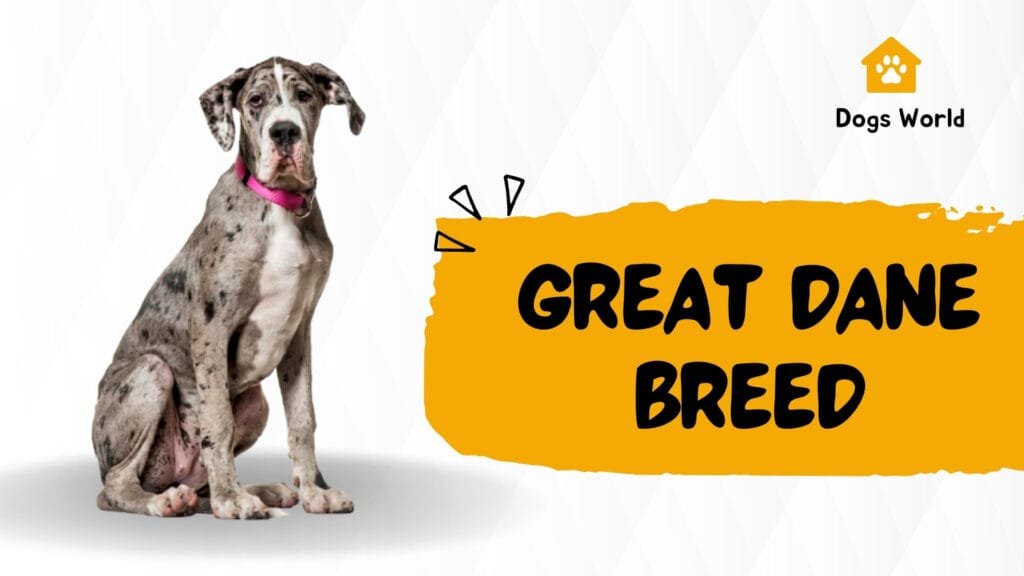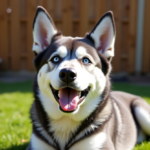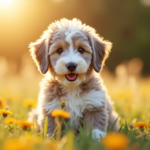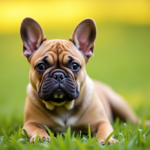The Great Dane is a giant among dogs, known for its massive size, gentle nature, and regal appearance. Often called the “Apollo of Dogs,” this breed is one of the tallest in the world, standing out with its graceful frame and friendly personality. Despite their intimidating height, Great Danes are affectionate and make wonderful family pets, especially for homes that can accommodate their size. These dogs are loyal, gentle with children, and protective of their loved ones, making them ideal companions for those looking for a big-hearted friend.
Originally bred in Germany for hunting wild boars, the Great Dane has a rich history that reflects its strength and courage. Today, the breed is loved for its calm demeanor, social nature, and striking coat colors like fawn, brindle, and harlequin. While they require careful attention to health, feeding, and grooming, Great Danes are surprisingly easy to care for with proper training and love. Whether you’re looking for a majestic family dog or a devoted companion, the Great Dane is a gentle giant that captures hearts wherever it goes.
Great Dane Overview
The Great Dane is a majestic breed with a blend of strength, grace, and charm. Originating from Germany, this breed was initially used for hunting large game such as boars. Over time, the Great Dane transitioned from a fierce hunter to a noble companion known for its loyal and affectionate nature.
Often referred to as the “Apollo of Dogs,” the Great Dane’s towering presence is complemented by its calm and friendly temperament. This breed thrives in a family environment, forming strong bonds with its human companions and often being particularly gentle with children.
Key characteristics of the Great Dane include its massive size, sleek coat, and soulful eyes that seem to convey intelligence and warmth. While their size may require ample space, their affectionate nature makes them ideal family pets for those ready to meet their needs.
Great Dane Highlights
- Impressive Size: Great Danes are one of the tallest dog breeds, often towering over their owners when standing on their hind legs.
- Loyal Companions: They are incredibly loyal and form deep bonds with their families.
- Gentle Nature: Despite their size, Great Danes are known for their gentle and calm demeanor.
- Short Lifespan: Unfortunately, their lifespan is relatively short, averaging 7-10 years.
- Special Care: Their size makes them prone to specific health issues like bloat and hip dysplasia.
- Social Dogs: Great Danes thrive on companionship and can experience separation anxiety if left alone for long periods.
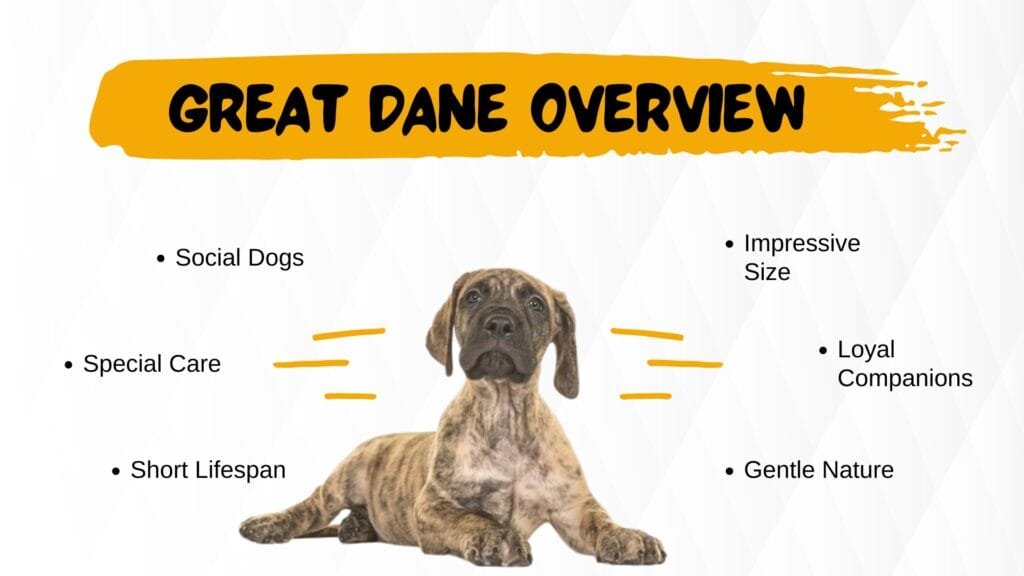
Great Dane History
The Great Dane has a rich and fascinating history that dates back over 400 years. Originating in Germany, the breed was developed to hunt wild boars—a task requiring immense strength, speed, and courage. Known as the “Deutsche Dogge” in its homeland, the Great Dane was initially a fierce and formidable hunting companion.
During the 18th century, Great Danes became a symbol of nobility. European aristocrats began breeding them for companionship, valuing their elegance and demeanor as much as their hunting abilities. Over time, the breed evolved into the gentle giant we know today, shedding its aggressive hunting instincts in favor of a calmer and more affectionate temperament.
The American Kennel Club (AKC) officially recognized the Great Dane in 1887, and the breed has since become a beloved choice for families worldwide.
Great Dane Size
The size of a Great Dane is one of its most striking features. Adult males typically stand 30-34 inches tall at the shoulder, while females measure 28-32 inches. Some exceptional individuals can reach heights exceeding 35 inches. In terms of weight, males range between 140-175 pounds, and females weigh 110-140 pounds.
Despite their massive frame, Great Danes carry themselves with grace and elegance. They are well-muscled yet lean, giving them a balanced and athletic appearance. Their size makes them a standout in any setting, and their calm demeanor ensures they rarely come across as intimidating.
This table can compare the size of Great Danes to other popular large dog breeds.
| Breed | Height (inches) | Weight (pounds) |
| Great Dane | 28–34 | 110–175 |
| Mastiff | 27–30 | 120–230 |
| Saint Bernard | 26–30 | 120–180 |
| Irish Wolfhound | 30–34 | 105–140 |
Great Dane Personality
A Great Dane’s personality is as lovable as it is unique. Often referred to as “gentle giants,” these dogs are known for their friendly and affectionate nature. They thrive on human companionship and are happiest when surrounded by their families.
Great Danes are excellent with children, displaying patience and gentleness that make them ideal family pets. While they are generally good with other animals, early socialization is crucial to ensure harmony in multi-pet households.
Despite their calm demeanor, Great Danes are alert and protective, making them excellent watchdogs. They rarely exhibit aggression but won’t hesitate to protect their loved ones if necessary.
Training a Great Dane is relatively straightforward, as they are intelligent and eager to please. However, their size and strength make early training essential to prevent behavioral issues as they grow.
Great Dane Health
While Great Danes are generally healthy, their size predisposes them to certain health issues:
This table can provide a summary of common health issues and how to prevent or manage them.
| Health Issue | Description | Prevention/Management |
| Bloat | Stomach twisting, life-threatening | Feed small meals, avoid exercise after meals |
| Hip Dysplasia | Improper hip joint development | Maintain healthy weight, regular check-ups |
| Dilated Cardiomyopathy | Enlarged heart leading to poor function | Regular vet monitoring, heart health diets |
| Osteosarcoma | Aggressive bone cancer common in large breeds | Early detection, appropriate treatment |

To ensure a healthy Great Dane, regular veterinary check-ups, a balanced diet, and appropriate exercise are vital.
Great Dane Care
Caring for a Great Dane involves meeting their physical, emotional, and medical needs:
- Exercise: While they don’t require excessive exercise, daily walks and playtime are essential to keep them fit and prevent boredom.
- Training: Begin obedience training early to establish good behavior and manage their strength.
- Living Space: Great Danes adapt well to indoor living but need ample space to move comfortably.
- Routine Check-Ups: Regular veterinary visits help detect and address potential health issues early.
Providing consistent care ensures your Great Dane leads a happy and healthy life.
| Care Aspect | Frequency/Details |
| Brushing | Weekly to reduce shedding |
| Exercise | Daily walks and moderate playtime |
| Nail Trimming | Every 3-4 weeks |
| Socialization | Begin in puppyhood to prevent anxiety |
Great Dane Feeding
Feeding a Great Dane requires careful planning to support their large size and prevent health issues:
- Puppy Diet: Choose high-quality large-breed puppy food to support controlled growth and avoid developmental issues.
- Adult Diet: Opt for a balanced large-breed adult formula. Divide meals into two or three portions to reduce the risk of bloat.
- Portion Size: Adjust portions based on your dog’s age, weight, and activity level.
Consulting a veterinarian ensures your Great Dane receives proper nutrition tailored to its specific needs.
Great Dane Coat Color and Grooming
Great Danes boast a sleek, short coat that requires minimal grooming. They come in several striking colors, including:
| Color | Description |
| Fawn | Golden-yellow with a black mask |
| Brindle | Fawn with black stripes |
| Harlequin | White with irregular black patches |
| Mantle | Black with white markings |
| Blue | Solid steel-blue |
| Black | Solid shiny black |
Weekly brushing keeps their coat healthy and reduces shedding. Occasional baths help maintain cleanliness, and routine nail trimming prevents discomfort.
Great Dane Children and Other Pets
Great Danes are known for their gentle and loving nature, making them excellent companions for children. Their patience and calm demeanor allow them to form strong bonds with kids. However, supervision is necessary with small children due to the dog’s size.
When introduced early, Great Danes get along well with other pets. Socialization during puppyhood is key to fostering positive interactions with other animals in the household.
Great Dane Rescue Groups
Adopting a Great Dane from a rescue group can be a rewarding experience. Some notable organizations include:
- Great Dane Rescue, Inc.: Specializes in rescuing and rehoming Great Danes across several states.
- Mid-Atlantic Great Dane Rescue League: Focuses on placing Great Danes in loving homes.
- Dane Outreach: Provides resources and adoption services in the Pacific Northwest.
These groups are dedicated to ensuring every Great Dane finds a suitable home.
Great Dane Breed Organizations
For Great Dane enthusiasts, breed organizations offer valuable resources and a sense of community:
- Great Dane Club of America (GDCA): Promotes breed standards and organizes events.
- American Kennel Club (AKC): Recognizes Great Danes and provides training, certification, and event information.
- Regional Clubs: Local groups offer meet-ups, training sessions, and breed advocacy.
Joining these organizations helps owners connect with fellow Great Dane lovers and stay informed about the breed.
Conclusion
The Great Dane is a breed that embodies grace, strength, and affection. Despite their massive size, they are gentle and loving companions that thrive in family environments. By understanding their needs, from health and training to feeding and grooming, you can provide a fulfilling life for your Great Dane.
FAQs
- How long do Great Danes live?
Great Danes typically live 7-10 years. - Are Great Danes good with children?
Yes, they are gentle and patient with kids but require supervision due to their size. - How much exercise does a Great Dane need?
They need daily walks and moderate playtime, but avoid over-exertion. - What do Great Danes eat?
High-quality large-breed dog food tailored to their age and activity level. - Do Great Danes shed a lot?
They shed moderately and benefit from weekly brushing. - Are Great Danes easy to train?
Yes, with consistent and positive reinforcement methods. - What colors do Great Danes come in?
Fawn, brindle, blue, black, harlequin, and mantle are common colors. - Can Great Danes live in apartments?
Yes, if given enough exercise and space to stretch out. - What health issues are common in Great Danes?
Bloat, hip dysplasia, and heart conditions are prevalent concerns. - Where can I adopt a Great Dane?
Consider breed-specific rescue groups or reputable breeders.

